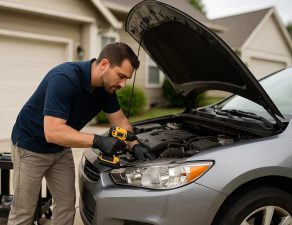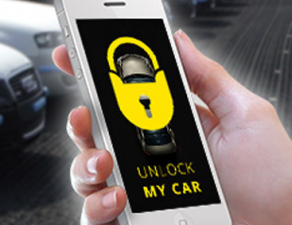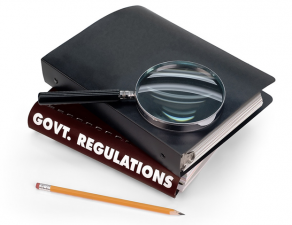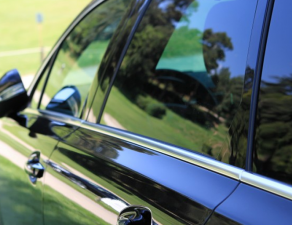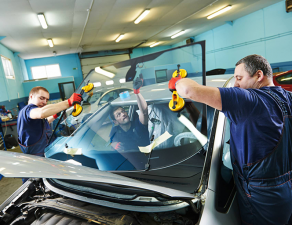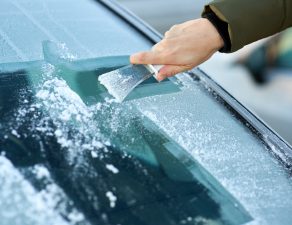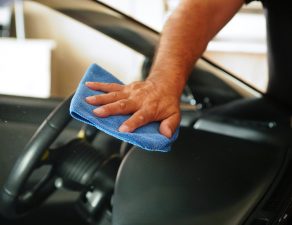So you’re driving to work in your newly-leased car, wide awake, going the speed limit, not texting, not eating jelly donuts, hands at 2 and 10, minding your own business, when suddenly—smack! The truck in front of you launches a pebble projectile right at your windshield. What starts out as a little impact ding spreads into an 8-inch long monster by the time you pull into the office. Now what?
There are a lot of myths out there about car repairs in general, but it seems like the mystery only deepens when your monthly payment is going towards a lease instead of ownership. And that’s just as true for the windshield as it is for the transmission. So here’s what you need to know about windshield repairs for your leased automobile:
Instantly Get Up to 3 Local Windshield Replacement Quotes
Avoid it if you can. We all know that flying debris on the road can happen at any time, but there are a few precautions you can take to reduce the chance that your windshield will be the next target. While it may not be possible to completely avoid semis, gravel trucks, and construction equipment on the road, always obey the signs on the backs of these large vehicles. No, not the ones that say “Honk if you love cheeses,” the ones that caution you to follow at a distance of 200 feet (about two-thirds the length of a football field, or a little less than the length of an average city block). Obviously that’s not always feasible, but if they are hauling loose or potentially dangerous material, do try to keep more space between the truck and your car.
The important thing to remember is that, in most states, you are legally responsible for covering your windshield damage if gravel from the truck hits the road before it hits your windshield. And even if the rock flew directly from the truck onto your window (without taking any detours on the pavement), it likely means you were following too closely anyway. Keep in mind, however, that when you’re driving, it’s almost impossible to document evidence of what exactly happened with the rock in question—unless you’re actually filming the situation at the time, which you probably don’t want to admit since we all know how unsafe that is.
Get the right car insurance policy—and know what it covers. This is important, not to mention legally required, whether you lease or own, but it becomes even more critical when you are leasing because the car dealership, who is kind enough to loan it to you for a monthly fee, still owns the auto. Most lease agreements state what type of insurance you must carry.
Generally speaking, you are required to get $100,000 per person liability coverage, property liability coverage to the tune of $50,000, and comprehensive and collision coverage for the actual value of the car. Note that this varies among lease agreements and insurance policies, so do your homework and find the policy that best fits your needs.
The good thing about having comprehensive coverage is that many policies will cover the cost of windshield repairs or even replacement—and depending on what state you live in, they may also offer other glass repair benefits.
Who is responsible for repairs? One of the nice things about leasing a car is that it is usually still under warranty, so the dealership is financially responsible for fixing any mechanical malfunctions. For regular maintenance (oil changes, tires rotated, etc.), however, the onus is on you. If you’re getting close to turning in your leased vehicle, be advised that any wear and tear from driving the car is your responsibility, too, so tone down the Mario Andretti impersonations. This means that you’ll need to repair or replace any windshield damage, get overall dings or scratches fixed, and replacing the tires if need be.
What to do if a rock hits your windshield. Report the damage immediately to your insurance company and get the repairs scheduled as soon as possible. Many companies will let you choose the windshield repair company to do the job, but don’t put this off and hope the crack will spontaneously disappear. A tiny ding can look benign for weeks until severe temperature changes turn it into a spider web crack that makes it seem like you’re driving through a circus funhouse mirror. And putting your hand against the windshield as you pass large trucks is not going to prevent chips and cracks from happening if a rock hits the glass.
The main thing to remember is that procrastination doesn’t pay—literally. Bigger repairs and replacements are always more expensive, time-consuming, dangerous, and will likely get you a fine from your friendly neighborhood police officer.
